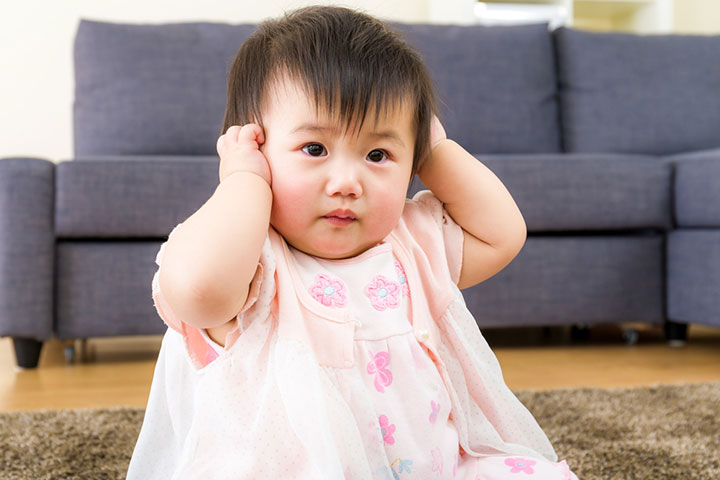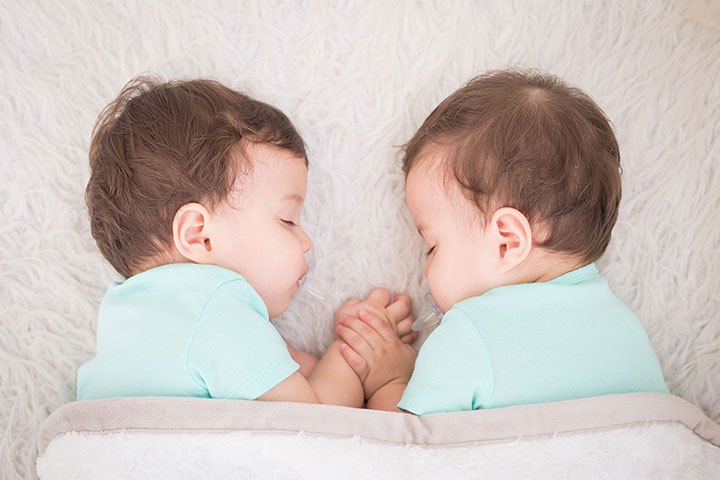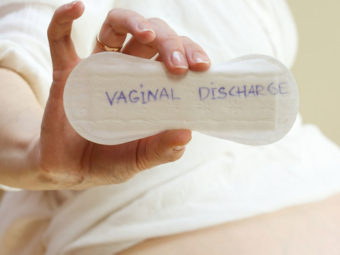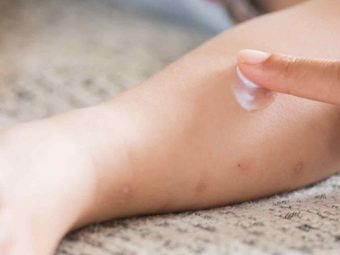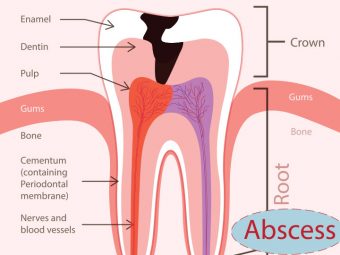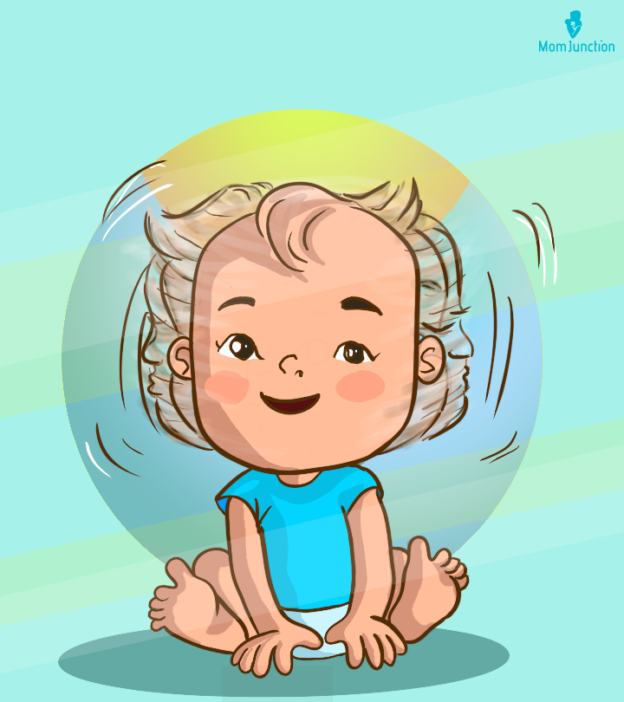
Image: Momjunction Design Team
You may notice a baby shaking their head while interacting with others or playing. Shaking their head from side to side is a common way older infants react to questions or communicate.Though head shaking is common in little ones, it could also indicate neurological or developmental problems.
Read this post to learn more about the typical and uncommon reasons babies shake their heads, how to deal with it, and when to consult a doctor.
Normal Causes Of Baby Head-Shaking
Are you wondering why babies shake their head from side to side? If you notice your baby is happy and healthy, then head-shaking is nothing to worry about. Here are a few usual reasons why your baby may shake their head.
1. Developing motor skills
Once your baby’s neck muscles are developed, they test their ability to hold up and move the head. It is a part of normal developmental milestones. Usually, by the end of the first month, a baby starts moving their head from side to side.The Centers for Disease Control and Prevention mention that by the age of two months, they can raise their heads while on their tummy(1).It may be jerkier initially due to developing muscle control and coordination.
2. Self-soothing
A baby shakes head side to side as a part of self-soothing. It can be anatural tactic to calm themselves down to sleep. You may notice this behavior right before your little one falls asleep.
Leah Alexander, MD, FAAP, a board-certified pediatrician in New Jersey, says, “If your baby starts shaking their head from side to side, it may be a sign that they are anxious, overstimulated, or trying to fall asleep. Self-soothing is a completely harmless way for babies to try and make themselves feel better in new situations.”
3. While breastfeeding
While breastfeeding, babies may shake theirhead to latch. It can be one of the first head movements babies may make. During nursing, they might also shake their head as a gesture to expressexcitement. Though your baby may support and move their head side to side, you shouldsupport their head while feeding until the age of three months.
4. Playing and interaction
Babies start to move their heads as a part ofsocial interaction in the initial months. You may notice increased head shaking when your baby is excited.
5. Communication
A baby may use head-shake as a mode of non-verbal communication.As the baby grows older, they may shake their head as a reflex, along with making sounds toexpress emotions or demandsomething.
 Quick fact
Quick factDr. Alexander says, “Most babies start shaking their heads to express a ‘no’ between 13 and 15 months old. However, some may start earlier and some may not start until later.”
Baby Head-Shaking Causes That Are Not Normal
If head-shake is associated with other physical and behavioral symptoms, then it could be due todevelopmental problemsor certainmedical conditions. We will touch on a few:
6. Ear infection or fluid collection in the middle ear
According to theNational Institute on Deafness and Other Communication Disorders, five in every six children will experience at least one ear infection by the time they reach their third birthday. Ear infections lead to pain or discomfort. This will often be associated with fever, crying, and other signs of illness. Ear tugging along with head-shaking may then occur(2).
7. Autism spectrum disorder
Image: Shutterstock
Babies withautismiXA developmental disability leading to issues with social communication and interaction or repetitive behaviortend toshake their head involuntarily. Frequent headbanging is sometimes observed with this disorder. In such cases, check for these associated behavioral traits.
- Does not respond to sounds
- No reaction if you call their name
- No smile or eye contact
The Centers for Disease Control and Prevention emphasizes that early diagnosis of autism disorders may improve the child’s quality of life due to early interventions and less parental stress(3).
8. Myoclonic epilepsy
Myoclonic head jerks or spasms can be seen in babies duringepilepsyiXA neurological condition that makes one more susceptible to recurrent seizures. According to the healthcare experts at the Boston Children’s hospital, theseseizuresiXA medical condition that causes an involuntary and uncontrollable surge of electrical activity in the brain往往发生在集群和may continue to happen multiple times in a day for several days. This may be due to serious neurodevelopmental disorders(4).
9. Spasmus nutans
It is a disorder where babies dohead-bobbingiXAn act of moving the head up in short and quick movementwithrapid eye movementcalled nystagmus. Sometimes, they may hold their neck in an abnormal position. As per the information available in the US National Library of Medicine, this condition usually occurs between four months and one year of age and resolves later in life(5).
 Did you know?
Did you know?Repetitive Side-To-Side Head-Shaking When Sleeping
Image: Shutterstock
Shaking of head side-to-side during sleep can be asymptom of rhythmic movement disorder (RMD).It is a neurological disorder with repeated movement of large muscles before or during sleep, especially in infants.It usually involves head and neck movements and has the following associated symptoms(6).
- Headbanging
- Body-rocking
- Head-rolling
This conditionmight be geneticsince it is often seen in families andamong twins. Seek a doctor’s opinion if you suspect RMD.
 Quick fact
Quick factWhen To Consult A Doctor?
You may consult a pediatrician if you notice any of the following events, along with head shaking.
- Poor interaction with caregivers
- Abnormal eye movements
- Headbanging causing hair loss and injury
- Increased head-shaking during anxiety
- Trying to self-hurt
- Delay in development
- No response to sounds
- Head-shaking after two years of age
 Point to consider
Point to considerHow To Stop Babies From Shaking Head?
Head shaking婴儿可能会导致头晕和迷失方向,and it may result in falls. It might also increase the risk ofhitting the crib, table, or wall. You may follow the following tactics to prevent your baby from head-shaking.
- If your baby does it before sleep, then try to find an alternative method to soothe them before they go to bed.
- If it is due to stress or agitation, thencreate a calm environmentin their room.
- Giving amassage couldhelp a baby to relax.
Image: Shutterstock
- If you sense that the baby shakes their head as a way tothrow tantrums, then do not give in to their demands. As soon asattentionis given (evennegative attention) it enhances the behavior.
Frequently Asked Questions
1. Can teething cause a baby to shake its head?
Some babies may shake their heads during teething. They may shake heads as a self-soothing behavior to cope with teething pain (7). It is a normal behavior in developmentally healthy infants during teething.
2. Why does my baby jerk his head back and forth?
Occasional back and forth movements of the head can be normal, especially when your baby is falling asleep. However, persistent bobbing of the head that is back and forth can be signs of neurological problems such as bobble-head doll syndrome (BHDS). This can be due tocystsiXA sac-like structure that may contain fluid, air, or other materialin the ventricles of the brain and can be treated with surgeries (8).
3. Do babies shake their heads when they are tired?
When tired, some babies shake their heads side to side to soothe themselves and fall asleep. Generally, this movement isn’t a cause for concern and is a mechanism some babies employ to feel less anxious.
Baby shaking head when awake and happy is typical and a good sign of motor skill development. They may use this action to interact and communicate. However, if you notice them shaking during their sleep or together with other concerning symptoms, do not overlook it. Although typical, a baby shaking head with crying, rapid movement, and other signs can indicate underlying morbidity that may require medical intervention. So stay mindful of your baby’s movements and behavior, and do not hesitate to consult your child’s doctor for prompt diagnosis and treatment.
Infographic: Less Serious Reasons For Baby Shaking Head
Although sometimes it might indicate a medical issue, generally, babies shake their heads in response to diverse stimuli. However, be observant of any unusual signs accompanying head shaking in babies. This infographic tells you about the possible common reasons infants usually resort to shaking their heads.
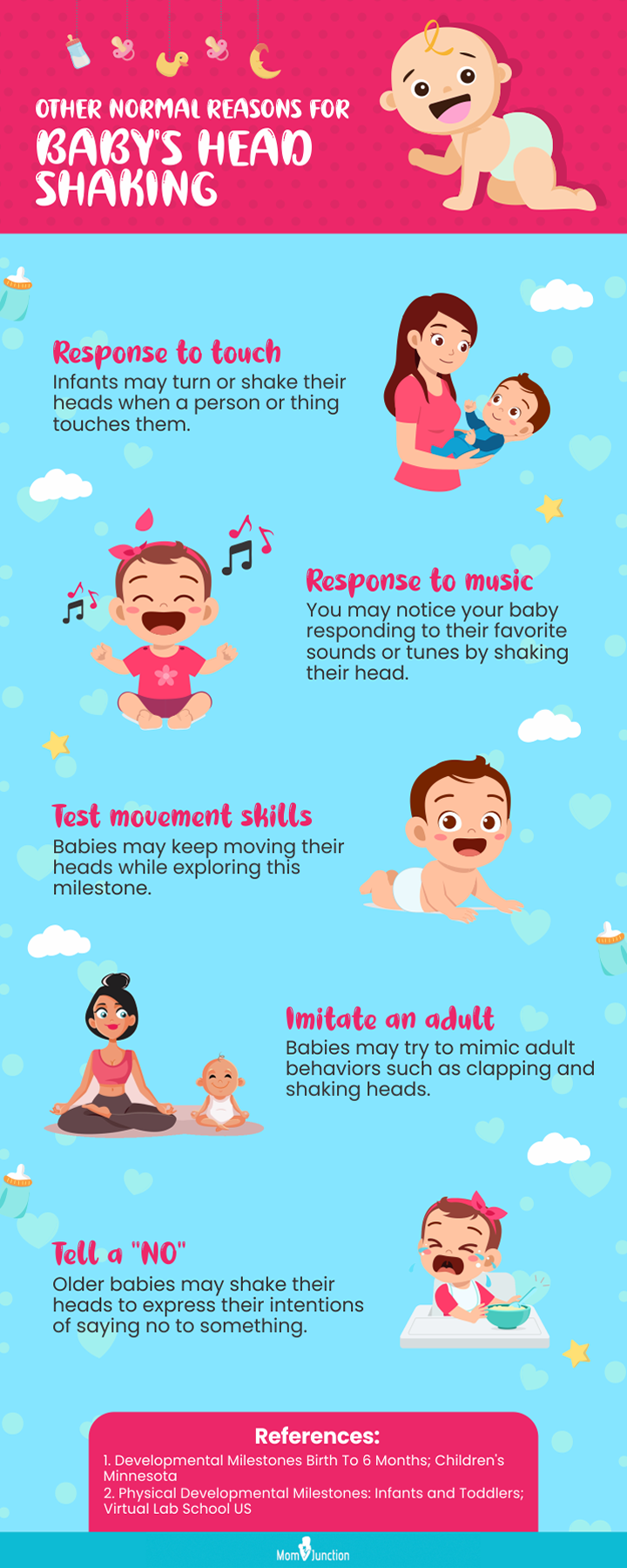
Illustration: Momjunction Design Team
Get high-quality PDF version by clicking below.
Download Infographic
Key Pointers
- If a baby is healthy and happy, parents shouldn’t worry about head-shaking in babies.
- Babies shake heads to hone their ability to keep holding their head up, self-soothing, or position their head to latch on to the nipple while breastfeeding.
- Shaking head side-to-side is the most common way older infants respond to a question or communicate.
- However, excessive or repetitive head-shaking indicates an underlying problem that a pediatrician must evaluate.
Learn about the 8 common early signs of autism. Discover what signs to look for in your child’s development and how to get help.
References:
2.Middle ear infection: Overview; Institute for Quality and Efficiency in Health Care; Cologne, Germany
3. Signs and Symptoms ofAutism Spectrum Disorders; The Centers for Disease Control and Prevention
4.Movement Disorders In Depth;Boston Children’s Hospital
5.Spasmusnutans; The United States National Library of Medicine
6. Jun Kohyama and Tomoyuki Takano, A boy infant with sleep relatedrhythmic movement disordershowing arm banging; Brazilian Association of Sleep
7. Hannah M Tully,et al;Persistent figure-8 and side-to-side head shaking is a marker for rhombencephalosynapsis; National Library Of Medicine
8.Bobble-head doll syndrome; National Organization for Rare Disorders
9.Hearing & Making Sounds: Your Baby’s Milestones; American Academy Of Pediatrics
10.Sandifer Syndrome; Birth Injury Help Center
11.Sleep Rhythmic Movement; American Academy Of Sleep Medicine.



